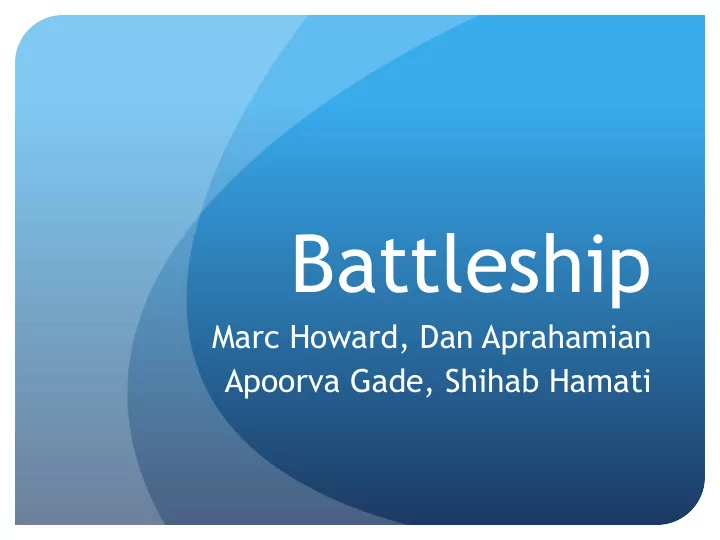

Battleship Marc Howard, Dan Aprahamian Apoorva Gade, Shihab Hamati
Game Concept Build the game Battleship on embedded hardware Build the game Battleship on a computer Get the two versions of the game to communicate via Ethernet in order to play a game
Graphical Layout
Hardware Implemented VGA Tile Manipulation Rotation Module Flip Module Invert Module VGA Tile Display Tile Storage (Memory) PS2 Keyboard Driver Ethernet Driver
VGA
PS2 Keyboard Interfaces with the VGA Selects the target tile for attack using the characters A-J and 0-9 for the 2 dimensions Arrow keys to navigate around the 2X2 array of tiles Uses the hardware provided in lab3 Software returns an appropriate string to the game logic software
Ethernet The 2 players communicate through Ethernet using IP/UDP protocols proper checksums DE2 Board has IP and MAC of PC hardwired PC sends ARP message to correspond IP and MAC of the DE2 Board, to which DE2 responds
Ethernet (Hardships) Ethernet not responsive Even after integrating DM9000A.vhd into project and establishing connections in top level .vhd Had to allow 16 cycles of delay to set reset_n signal In a loop, first about 100 packets not sending Had to allow a delay after initializing DM9000A controller Received bytes had a lot of errors Reason: Ethernet clock synchronization delays Using PLL instead of a logic code to create 25 MHz clock from 50 MHz
Game Programming Implemented in Python on computer Implemented identically in C on embedded system Only changes came in the form of wrapper functions to interact with hardware, which had identical headers on both systems. Used Tkinter, PIL, and Socket libraries for Python Embedded system goes first. Computer goes second.
Game Logic 1. Get name from user (PS2 Input) 2. Have user place ships 3. Exchange names with opponent (Ethernet) 4. Take a turn – Select a square and fire a shot (Ethernet) 5. Wait for a shot from opponent and respond (Ethernet) 6. Repeat 4 and 5 until one player reaches 17 Hits 7. Ask if player wants to play again. If so go to 2, if not go to 1.
Problems VGA On-Chip RAM too small for tile image data - Used SRAM instead Required using SDRAM for program; much more work. Slight image shift depending on monitor used (negligible) PS2 Keyboard Repeated signals from keys – solved in software Ethernet ARP requests – solved by having board send ARP response Garbage packets from switch - Filtered out in software Switch often lags sending packets (Big problem!) Some packets consistently get a byte garbled (Big problem!)
Accomplishments Successfully implemented and integrated all hardware components Made game run perfectly as long as Ethernet is not involved (Game startup and ship placement) Can demonstrate Ethernet capability with one round of combat by pushing a packet through multiple times (game is robust enough to wait until it receives the right type of packet before continuing).
Demonstration
Questions?
Recommend
More recommend